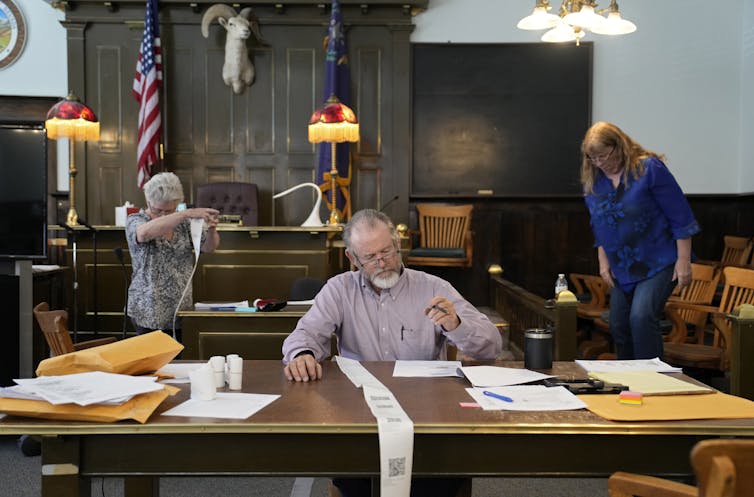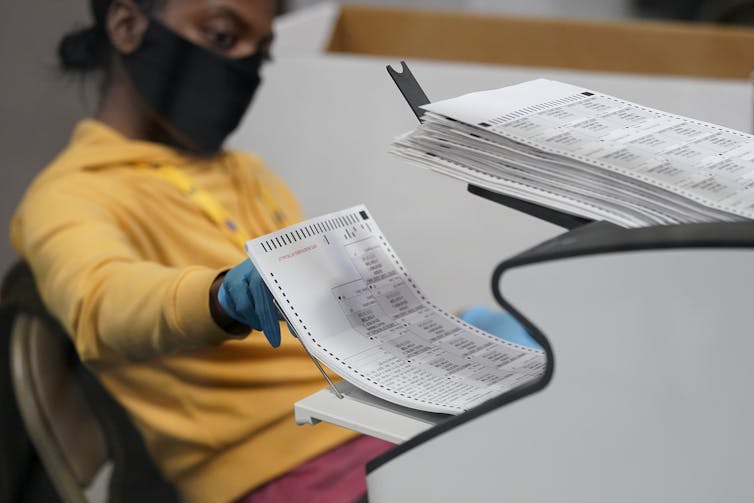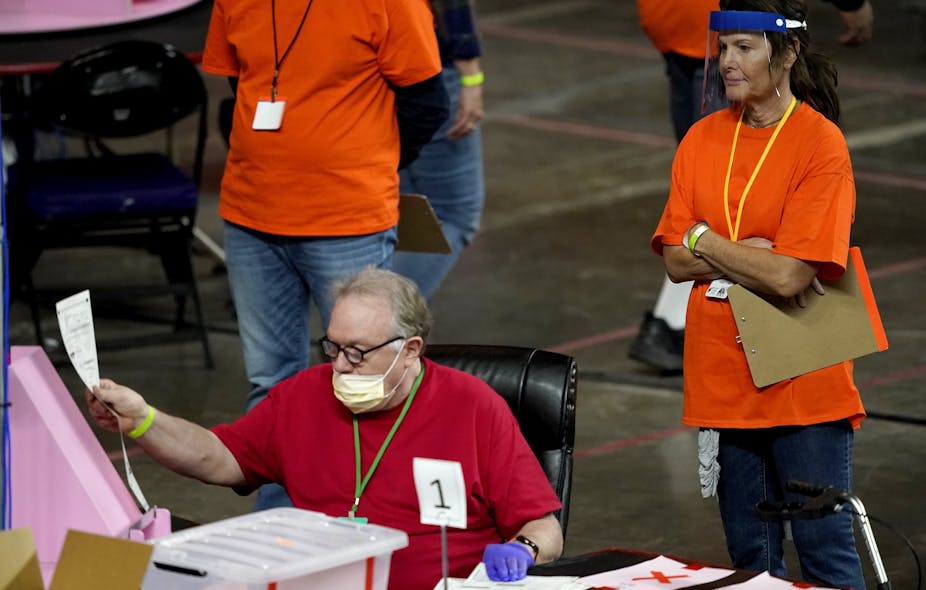Among people, mostly Republicans, who remain the most suspicious of the 2020 presidential election results, there’s something of a movement to return to the days when election ballots in the United States were counted by hand. One 67,000-person county in Georgia recently required a hand count of all ballots, for instance. But they, and others seeking similar changes around the country, are likely to find themselves disappointed – either by failure to mandate hand-counting or by how election results are handled if they succeed.
Requiring hand-counting of all ballots would take elections back many decades to practices that were common in the mid-1800s. In that era, political parties produced a variety of paper “tickets” that were counted at polling places on election night. When states started taking responsibility for producing ballots in the late 19th century, automated machines began to be used for both casting and tabulating votes.
In a 1930s review of voting processes, political scientist Joseph Harris concluded that “[p]robably no part of election administration is conducted so poorly as the count of ballots.” Several of the improvements he suggested were in fact adopted after World War II, helped along by new technologies that were faster, more consistent and less prone to error – like optical scanning systems. Today, the overwhelmingly dominant technology uses paper marked ballots that are tabulated by scanner machines.
It is easy to see why a hand-count system seems appealing to many people today. Having ballots scrutinized in person by representatives from the parties provides obvious transparency and accountability. The true result of the infamous 2000 Bush-Gore contest in Florida remains in doubt, in part, because a hand recount of this kind was not ultimately conducted. States such as Georgia and Wisconsin have undergone hand recounts of the votes cast in their presidential elections. And other democracies such as France hand-count ballots. In short, it seems possible.
But as a scholar of elections, I know that despite the intuitive appeal of people physically counting pieces of paper, there are two good reasons to avoid hand-counting ballots: speed and accuracy.

Hand counting is slower
It takes a long time to count ballots by hand. Counters must pause for regular breaks to stay rested and sharp. Counting must periodically stop to resolve challenges and questions from observers. It is painstaking work. But, in part thanks to mechanical and technological counting systems, Americans have come to expect election results to be available very quickly, even just a few hours after the polls close.
Most U.S. election ballots are long and would require counting of many contests, from president down to county commissioner and probate judge. In other countries where hand counting is used, there is typically just one race on the ballot. But in many parts of the U.S., it is common for there to be a dozen contests or many more during each election – and on a single piece of paper. Sometimes a ballot paper has two columns for voting, with candidates or ballot questions on both the front and the back of the ballot page.
In recent high-profile recounts, usually only one office is being recounted, so the rest of the ballot is ignored. When Georgia officials recounted the 2020 presidential race, it required thousands of ballot counters working long shifts that spanned multiple days for just that one contest. Even with such a dedicated effort, the hand count took almost a week to complete – and cost the state millions of dollars.
A hand count of more than one contest multiplies the amount of time needed to produce a preliminary election result. It might seem like having 10 races on the ballot would take about 10 times as long as counting a single contest. However, it is likely to take much longer than that.
This is because ballots are printed for very small groups of voters, and include only the specific legislative and municipal districts in which they live. Recounting a single statewide election is one thing, but hand-counting the entire ballot actually requires a different, more cumbersome procedure because hundreds or thousands of combinations of other contests need to be broken out. If only a presidential race is being counted, workers can use a simpler “stack and count” procedure to make piles of votes for each candidate. But if multiple races are being counted, a more complex “read and mark” procedure is required. The reader must call out each race - from president down to probate judge – marked on the ballot so that other workers can keep tallies. This process requires more people and more time.
Hand counting is less accurate
Even if the public and the candidates were willing to tolerate the slowness of a hand count, its lower level of accuracy is a serious problem. The point, after all, is to get the result right.
Humans are better than machines at many tasks, but people are not good at highly repetitive tasks such as ballot counting that require extreme accuracy. Humans reviewing thousands of ballots become tired and make many different kinds of mistakes, such as losing track of their counts.
In contrast, dedicated tabulator machines, which are used after voters have marked their ballots, are excellent at counting. The tabulators used in most election districts around the country are optical scanners that read standardized ballots and have lower error rates than most other technologies. More importantly, detailed data from recounts shows that scanners and other tabulation devices are significantly more accurate than counting the same ballots by hand.

A place for hand counts
Although hand-counting ballots on election night does not make sense in terms of speed or accuracy, there are parts of the election process where hand counts are extremely helpful.
Most states conduct post-election audits that review ballots to ensure that they were correctly tabulated. Recounts after close elections also frequently entail human review of ballots to verify the initial results.
In both of these situations, many of the problems of hand-counting are rendered irrelevant. For instance, many recounts focus on small batches of ballots rather than the full statewide collection of votes. Recounts also typically focus on a single contest and do not require a review of the entire ballot. With both audits and recounts, the speed of the count is not as important, so most participants are willing to wait a bit longer to verify the election night counts.
Nearly every voter in the next U.S. presidential election will be casting votes either on paper or on an electronic machine that has a paper backup. And almost all of those ballots will be counted by a machine. This approach balances security, accuracy, speed and voter confidence – and still allows for selected hand counts after election day.

